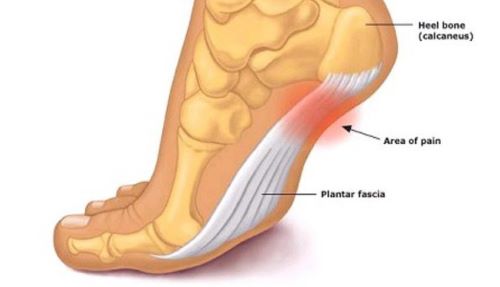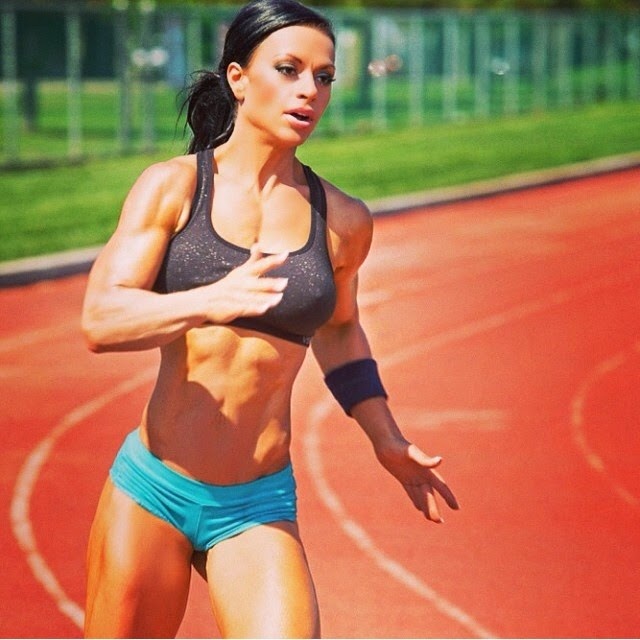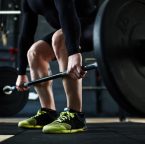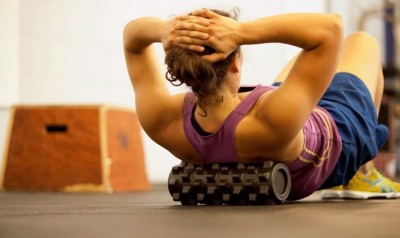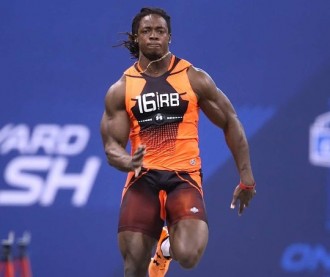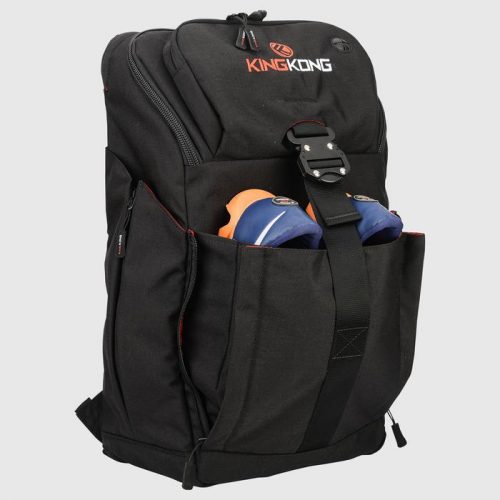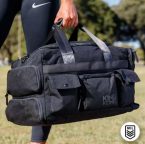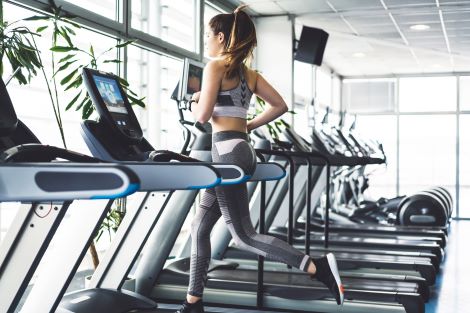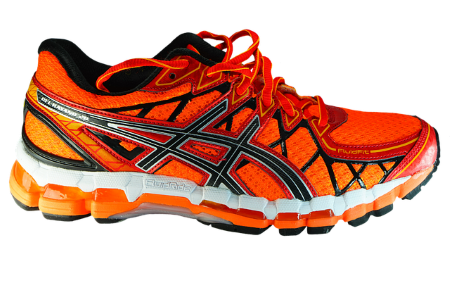
Having plantar fasciitis can be a literal pain, especially if you’re the type who engages in sports and physical activities regularly.
The condition involves heel pain and marked inflammation of the plantar fascia, a stretch of tissue that connects your toes to the heel bone. Curiously enough, plantar fasciitis is more common among runners, overweight people and individuals who wear inadequate shoes.
For runners, does having plantar fasciitis spell the end for your beloved hobby?
The good news is that it doesn’t. One of the best ways to address plantar fasciitis is by using running shoes that support your feet in the areas that matter most.
The 10 Best Running Shoes for Plantar Fasciitis
If your feet hurt from plantar fasciitis, these running shoes are the best options.
1. Hoka Clifton 9
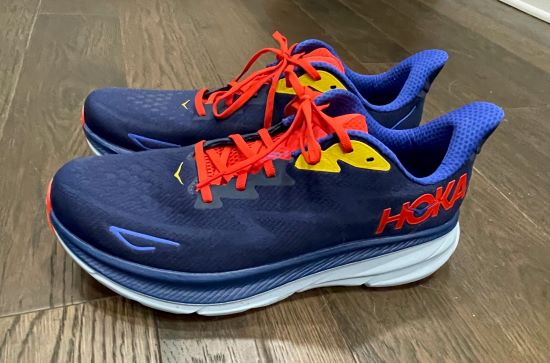
This article has been around for a while, time to update it with a new top selection (4/1/23)
There is a new king in town. If you have plantar fasciitis and are looking for a good running shoe that offers comfort and arch support.
After wearing the Brooks Ghost for the last couple of years I decided it was time for a change. I headed to Dick’s Sporting Goods to try on some shoes. The Hoka Clifton 9 was the first shoe I tried, and I instantly fell in love. The cushion and support were unreal. It blew my old Brooks Ghosts out of the water.
Granted the Ghosts were old, but they were never this good.
I also tried on the Hoka One One Bondi and it was nice but didn’t seem to offer the arch support that the Cliftons did. The Bondi also had a thick sole that would take some getting used to.
Clifton was the easy choice. It was like walking on pillows with arch support. The actual pair I bought are pictured above.
Here is more information on the Clifton, aside from just me gushing over it.
The Clifton is a popular shoe among runners due to its cushioning and lightweight design. The shoe is designed to provide a comfortable and responsive ride while minimizing impact on the feet and joints.
Regarding arch support, the Hoka Clifton features a high amount of support. The shoe has a slightly curved shape, which helps to cradle the arch and provide stability. Additionally, the midsole is made of a material called EVA foam, which provides a balance of cushioning and support.
It’s worth noting that the amount of arch support needed can vary from person to person. It works fabulously for me but might not for you. I recommend you try any of these shoes on before you buy them.
Pros
- Provides cushion and arch support
- Great for long-distance runners
- Easy to slip off and on
- Not sluggish, heavy or unresponsive
- Less expensive than other Hoka Shoes
Cons
- Not great for speedwork
- Color selections are average at best
2. Asics Gel-Nimbus
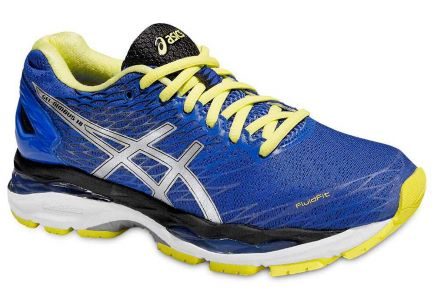
Asics has always delivered great-looking running shoes in the past, and the Gel Nimbus is no different. The brand doesn’t compromise on what’s inside either- you get top-notch support for heel pain when running over great distances.
Neutral and Underpronation runners will love the fact that the Gel Nimbus is one of the best shock-absorbing shoes around. Aside from the newer GEL cushioning unit in the fore and heel area, you also get TRUSSTIC technology in the shoe’s arch for reduced weight, stability and product longevity.
High mileage runners will appreciate the midsole foam which disperses high impact force in the midsole. Engineered mesh upper and a superb AHAR outsole means you won’t be changing running shoes ever so often.
Get the Asics Gel-Nimbus if you want a comfortable run even over great distances and a shoe that’s top-rated in durability.
Pros
- Excellent for Neutral and Underpronated runners
- Reasonable price
- Great color selection
Cons
- Not recommended for Overpronated runners
3. Brooks Ghost
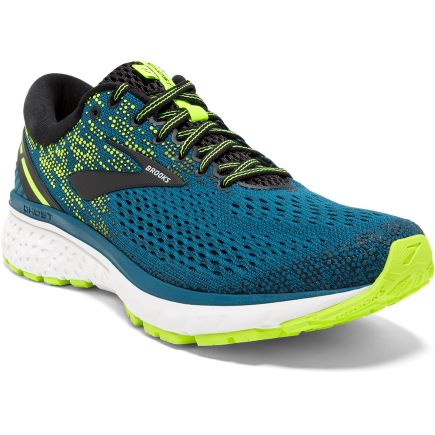
The Ghost running shoes by Brooks is aptly named because it has that ‘barely there’ feel. Brooks says that their running shoes have BioMoGo DNA and DNA Loft for impressive tactile response and comfort.
Look beneath the shoe and you’ll find a set of shock absorbers for seamless heel-to-toe transitions. Flex Grooves ensure that your fore area gets enough flexibility to stave off foot problems and deformities.
What we love about the Ghost is that it has 3D Fit Print, which is a unique feature with the brand. A combination of structure and stretch materials are placed where they’re appreciated most.
Each pair comes with a trial run guarantee, meaning you can return it at no cost if you’re not satisfied within 90 days. First-timers can try it out and see if it’s better than their current running shoe brand for free!
If I had to pick the best running shoes for women with plantar fasciitis pain this would be it. My wife loves them, great color options and a great fit.
Durability may be an issue with this shoe, my latest pair is pretty beat up for only being 6 months old. The sole is all beat up along the outside by the heal and the material around the toe area is fraying a little which is a little disappointing because the shoe is very comfortable.
Pros
- Excellent lightweight materials
- Has 90-day moneyback guarantee
- Good fit and feel
Cons
- May be too soft for some
- Durability may be an issue as of late
4. Mizuno Wave Inspire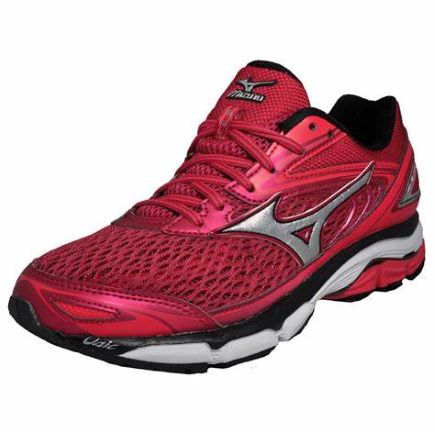
Overpronators don’t have much choice when it comes to good running shoes, until now. The Wave Inspire series was made especially for these types of runners, with features that can ease foot pain from plantar fasciitis.
Remember what we said about toe boxes? The Wave Inspire has superior forefoot softness due to increased blown rubber. Then, Mizuno adds technologies such as the X10 for extra durability on areas that wear out faster while supplementing heel strike traction, the SR Touch for improved shock absorption and rebound, and the U4IC for midsole compounds.
It’s also one of the most breathable shoes ever due to AIRmesh, Mizuno Intercool, and Premium InSock. Somehow Mizuno has made a soft and comfortable structure that provides just the right amount of bounce.
On top of all that, this has been my personal running shoe for the last few years, and I love it.
Pros
- Great breathable material
- Double Fan Wave for dynamic cushioning and support
- The Overpronator’s best friend
Cons
- A bit more expensive
Related: The 15 Best Shoes for Cross-Training
5. Brooks Glycerin
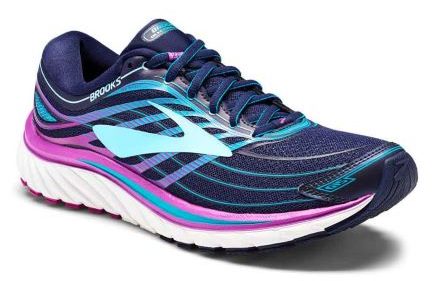
Brooks’ Glycerin running shoes are tailored for maximum cushion and ride. The product has four points of interest and makes for good casual shoes when you’re expecting a bit of action.
DNA Loft is the shoe’s strongest point, offering incredible forefoot cushioning without loss of durability or tactile response. A plush transition zone makes heel-to-toe contact smooth and seamless. It’s worthy to note that this helps ease the heel pain commonly associated with plantar fasciitis.
For those who want to get a natural running feel, you’ll love the OrthoLite sock liner, which gives you extra comfort. Last but not the least, engineered mesh ticks all the right boxes, e.g., structure, breathability, and flexibility.
Brooks has always been known for outstanding support. Each pair of Brooks running shoes has a 90-day unlimited sweating or ‘trial period’ so you can gauge if the product is right for you.
Pros
- Unbeatable softness and cushioning
- Value for money
- Urban design looks snappy and casual
Cons
- Jack of all trades, master of none
6. Asics Gel-Kayano
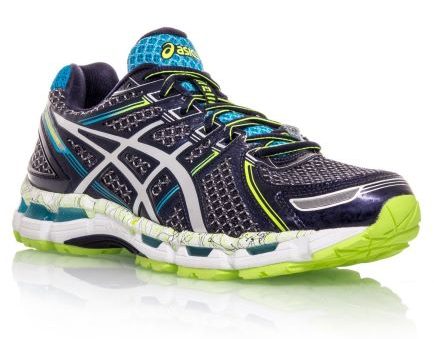
Here’s another fantastic option for those struggling with plantar fasciitis, and it’s yet again from Asics. Meet the Asics Gel-Kayano, a shoe that’s in a league of its own when it comes to stability.
You see, the Gel-Kayano’s design is pretty unique. It’s inspired by the hard shell of a stag beetle. Yeah, you read that right! Toshikazu Kayano looked at nature, saw the beetle’s tough exterior, and said, “Let’s make a shoe that’s just as strong.”
The result is a shoe that’s more than just durable; it’s a blend of comfort and innovation. The support structure is like a handshake for your foot, holding it in just the right way, thanks to GEL technology cushioning. And that shear deformation? It means that when your foot hits the ground, the shoe’s sculpted incline absorbs the shock like a champ.
But it’s not just about absorbing impact; the Gel-Kayano wants to make you feel like you’re gliding. With adjusted heel geometry and FLYTEFOAM Propel technology in the midsole, each step feels springy, like the shoe’s giving you a little extra push.
Now, you might be thinking that sounds great, but will it hold up? This shoe isn’t just about short-term comfort; it’s built for the long run. The cushioning is durable, the support’s reliable, and with DuoMax, you don’t have to worry about overpronation roll adding extra stress to your ankle.
Pros
- Has some of the best structural support you can get
- Asics quality and build
- Very durable
- Great for people with flat feet
Cons
- A bit heavier than other running shoes
7. Hoka One One Bondi
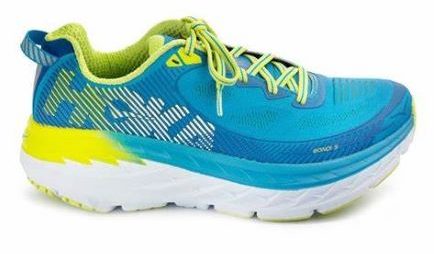
The Bondi is categorized as a ‘road shoe’ and is versatile in every which way. Whether you’re running on concrete and gravel, or decide to go the off-beaten path and traverse on clay or grass, the level of traction and stability stays the same.
The latest iteration has a larger toe box to give you some extra wiggle space. Hoka One One describes the Bondi as a road shoe with ‘squishy soft’ feel and lightweight materials. One thing you’ll notice is the extra thick outsole which means you won’t be wearing it down anytime soon. And yet the whole shoe feels feather-light and won’t weigh you down.
You get a strong tactile bounce and feel on any road surface with the Bondi. In terms of comfort and cushion, it certainly belongs in the top tier. The running shoe can double as casual footwear for when you’re out and about most of the day.
Pros
- Thick outsole
- Superior comfort
- Good design options
- Wide toe box
Cons
- A bit more expensive
- Thick sole takes some getting used to
8. New Balance Fresh Foam 1080
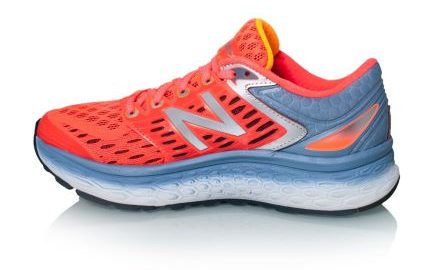
New Balance has been around the block and is a well-respected brand. Their latest running shoe, the 1080 can be bought at personalized width, e.g., from Narrow to X-Wide for that extra customization.
You’ll find that Fresh Foam technology lies in the heart of this running shoe. The midsole is made of Fresh Foam and offers a greater kinetic rebound than the competition. It’s premium cushioning at a very affordable price!
The midsole is thick just like Bondi with one special addition- laser engraving takes out the excess weight and adds a nice flexibility to the package. An Ultra Heel and Hypoknit gives your feet a snug fit without compromising on looks.
Pros
- One of the cheapest in the list
- Very lightweight and stable
- Has width options
Cons
- Wears out pretty quickly
9. Altra Torin
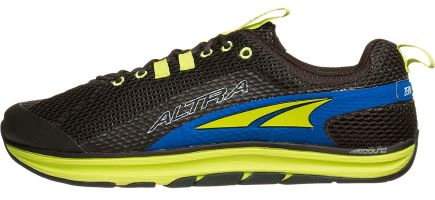
Torin is a favorite among runners as it’s usually the go-to pair for long-distance marathons. You get balanced cushioning due to the fact that your forefoot and heel are the same distance to the ground, which means lesser impacts. The Footshape Toe Box is a welcome addition for those who want their toes to be limber and relaxed.
Altra has managed to map your foot’s tendons and bones in the outsole technology, allowing it to move and shift naturally. The midsole is made of Quantic material and is exclusive for Altra enthusiasts.
Pros
- Offers sufficient toe room
- Fantastically lightweight
- Responsive and comfortable
Cons
- Lycra patches may feel restrictive
10. Brooks Adrenaline
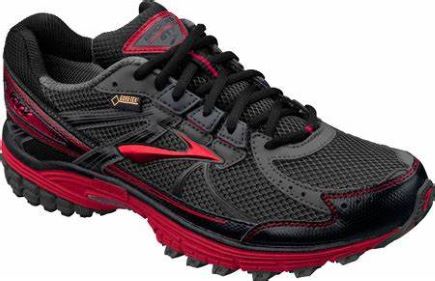
The Adrenaline running shoe by Brooks touts a new technology called GuideRails support system for responsive and ultra-soft cushioning. It keeps things low impact, especially for your knees with a couple of features- the DNA Loft and BioMoGo DNA for balanced cushioning, and a modernized fit via the 3D Fit Print and engineered mesh.
It’s not every day a running shoe works to stabilize your natural range of motion, and Brooks has managed to hit that nail squarely on the head. Couple that with excellent support and a satisfaction guarantee and you have yourself a quality buy.
Pros
- Innovative GuideRails system
- Superb value for money
- Brooks brand quality
Cons
- May fall short in professional performance
11. Mizuno Wave Rider
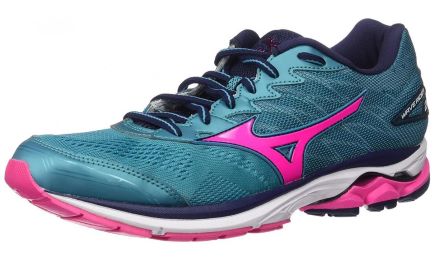
The Mizuno Wave Rider has gone through several iterations, all in the name of progress. Runners with plantar fasciitis can still go the distance with the help of this remarkable pair of shoes.
Extra cushion is added via the articulated U4icX within the heel wedge area. A new foam has been incorporated in the midsole foam for added durability tactile response. A softer collar stops irritation from sweat and prolonged running without sacrificing grip.
Mizuno’s engineered mesh keeps your feet stable and able to breathe and move about. On top of that, you get a slick-looking pair of shoes that will turn heads wherever you go.
Pros
- Stylish and well-designed
- Good balance and durability
- Excellent walking shoes
- Has Premium InSock technology
Cons
- Not cheap
How We Decided On the Best Plantar Fasciitis Running Shoes
Finding the best running shoes for plantar fasciitis wasn’t just a stroll in the park; it took some serious digging and analysis. We knew that the perfect pair needed to have a special blend of characteristics to really ease the discomfort associated with plantar fasciitis. So, here’s how we broke it down:
- Price: We all want quality, but let’s be real; the price tag matters too. We searched for shoes that provide great value for the investment, balancing top-notch features without breaking the bank.
- Comfort: When you’re dealing with plantar fasciitis, comfort isn’t just a luxury; it’s a must. We tried on, jogged in, and put these shoes through their paces, all to ensure they felt like a cozy hug for your feet.
- Reviews: What better way to gauge a product than by hearing from those who’ve actually worn them? We scoured online reviews and customer testimonials, listening to the praise and the gripes to find the real gems that live up to the hype.
- Arch Support: Plantar fasciitis demands some serious arch support. We focused on shoes that provide that perfect balance – not too rigid, not too soft, just the right support to keep that arch happy and pain-free.
- Cushion: Lastly, but certainly not least, we looked at cushioning. The ideal cushioning absorbs shock and provides that gentle support that can make all the difference. A good cushion can transform a run from a painful slog to a joyful jog.
In the end, we narrowed down our list to options that truly stand out in these key areas. Whether you’re a seasoned runner or just someone looking to keep plantar fasciitis at bay while enjoying a casual run, we’ve found options that should make your feet feel right at home.
What is Plantar Fasciitis?
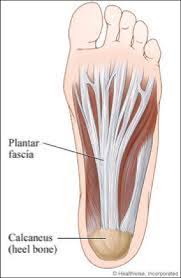
Before we get into the shoes let’s talk about what plantar fasciitis even is.
The plantar fascia is a thick band of tissue that runs along the bottom of your foot. It connects your toes to your heel. It supports the arch of your foot and it needs to maintain a certain level of tension in order to do so.
If you do a lot of running, the plantar fascia can become irritated and inflamed. This can make the bottom of your foot and heel painful, especially in the morning.
There are a number of things you can do to help with your plantar fasciitis. We have covered these extensively in our article Plantar Fasciitis: Treatment and Prevention Guide, but for this article, we will be looking only at the best running shoes. And let me tell you, your shoes can make a BIG DIFFERENCE.
Best Stretches For Plantar Fasciitis
Plantar fasciitis got you down? Marathon runner and podiatrist Tim Karthas, DPM, has got some news for you. He explains that keeping your calf muscles flexible and releasing tension in the foot ligaments might not just ease that pesky pain but prevent it in the future too. Seems that tight calves can actually increase the risk of plantar fasciitis by reducing ankle mobility and putting extra stress on the foot’s fascia.
Sure, compression socks for plantar fasciitis can be your best friend on off days, but stretching? That’s the real deal. Here are some stretches for runners, thanks to Prestipino, that might just help you out:
- Leg Stretch: Lie on your back, lift a straight leg back toward your head with your feet flexed. If you’re not a gymnast, a yoga strap or towel might be handy to guide the movement. Bend those toes toward your head to stretch the calves. Hold it for 20-30 seconds, repeat thrice, then give the other side a go.
- Stair Stretch: Stand facing some stairs, feet on the bottom step and heels enjoying the view. Lower those heels slowly to say goodbye to calf tension. Hold for 20 to 30 seconds, repeat thrice, and feel free to revisit up to 2-3 times a day. Got a heel spur with your plantar fasciitis? Maybe skip this one.
- Staggered Stretch: Stand with one foot forward and one back (hip-width distance, nothing crazy). Bend the front knee, keep the back leg as straight as a ruler, and if you’re feeling adventurous, bend your torso toward the knee. This gets right into that soleus calf muscle for an even deeper stretch. Hold for 20-30 seconds, repeat thrice, then switch those feet around.
- The Figure-4 Stretch: Sitting down? Cross one leg over the other and make a figure-4 with those legs. With flexed feet, pull back those toes, especially the big one, for a satisfying stretch. Hold for 15 to 20 seconds and repeat thrice. Do this up to 2-3 times a day, and your feet might just start loving you back.
What to Look For in Running Shoe for Plantar Fasciitis
So, what are the elements that make a running shoe a good fit for someone who has plantar fasciitis? Take a look at the ones below.
Arch Support
When looking for the best running sneaker for plantar fasciitis it is essential to have good arch support. Arch support is a feature that can eliminate the many pains associated with foot problems, including plantar fasciitis. Moreover, it adds to the level of comfort you get especially when standing or walking for long periods of time.
In a sense, the downward pressure caused by running or standing gets evenly distributed across the arch area and adds balance and stability.

Shock Absorption
Shock absorption is another useful feature to have and can make a huge difference in the quality of your exercise. In the simplest terms, the force of impact that pushes downward dissipates, thereby making running easier on the feet and joints.
Flexible Toe Box
It’s not enough for a shoe’s toe box to be shaped just right. You’ll need one that’s flexible and wide enough that you can wiggle and spread your toes during breaks.
Cushioning and Comfort
Various running shoe brands will have different cushioning technology for comfort and performance. Sometimes finding the right shoe will depend on the type of cushioning and if it’s more comfortable for you based on experience.
At the end of the day, it’s all about not getting foot fatigue after a long, hard run. You’ll want to take care as to not aggravate your plantar fasciitis and giving your feet the shoes they deserve.
FAQ
Are Brooks or Hoka better for plantar fasciitis?
It is difficult to say which shoe brand is better for plantar fasciitis, as it will depend on each individual’s unique foot shape and needs. I would go to a store and try on both brands to see which works better for you.
Do running shoes help plantar fasciitis?
Yes, running shoes are likely the best option for support and cushioning to help relieve the pain associated with plantar fasciitis. Running shoes that have extra cushioning and arch support are most effective in providing relief.
What shoes should you not wear with plantar fasciitis?
High heels should be avoided as they cause the feet to strain and can increase the pressure on the arch of the foot, which can make symptoms worse. Work boots should have enough cushioning and arch support to provide relief but you may want to get an insert for your work boots depending on the brand and how much support they have (my Timberlands have almost no support). You should also watch out for boat shoes and other shoes that have little support in them.
How do athletes get rid of plantar fasciitis?
Athletes can help manage their plantar fasciitis by stretching their calf, arch and heel muscles regularly, wearing supportive shoes with plenty of cushioning and arch support, using ice or heat therapy on the affected area, and taking over-the-counter pain relief as needed. Also, rolling a lacrosse ball on the floor with your foot can massage the plantar fasciitis and provide relief.
Conclusion
Running with plantar fasciitis doesn’t mean the end of your hobby. Take your pick on the best running shoes depending on your preference and enjoy the improved quality of life it brings. You’ll know if it works when you don’t experience heel pain as much as you go about your day or take a route around the neighborhood.

